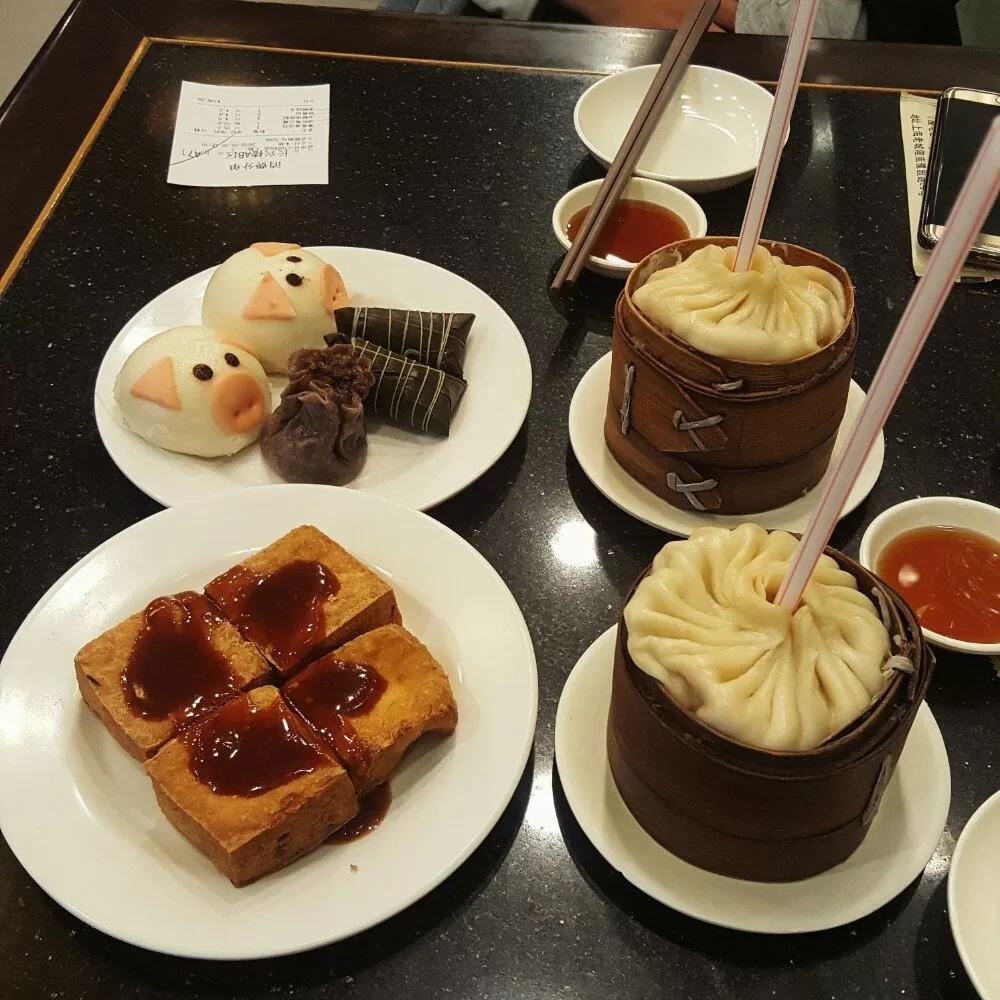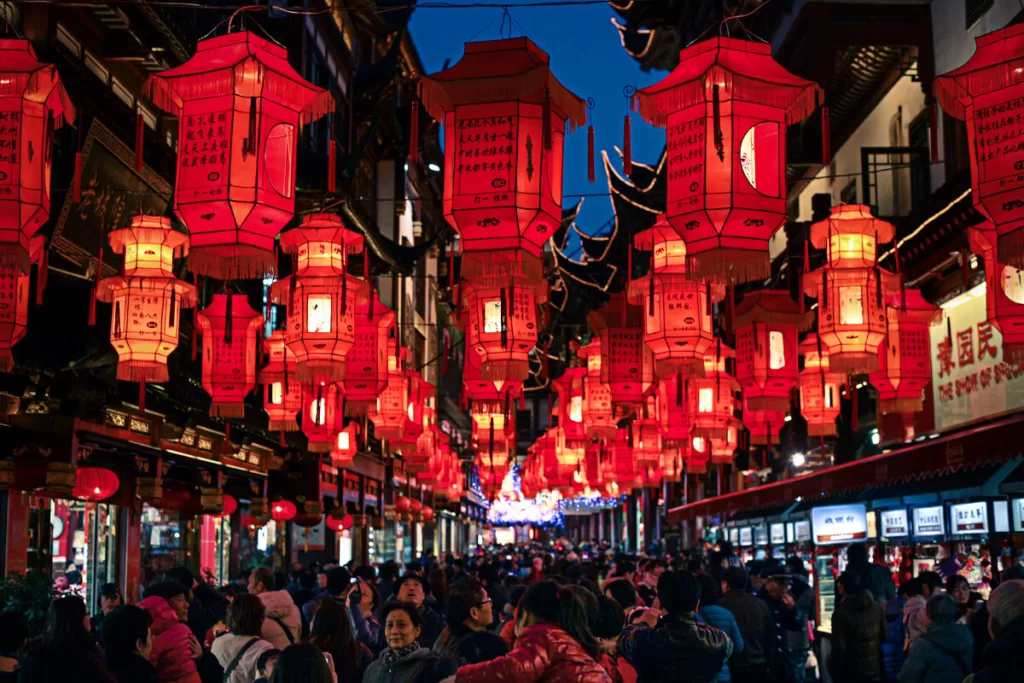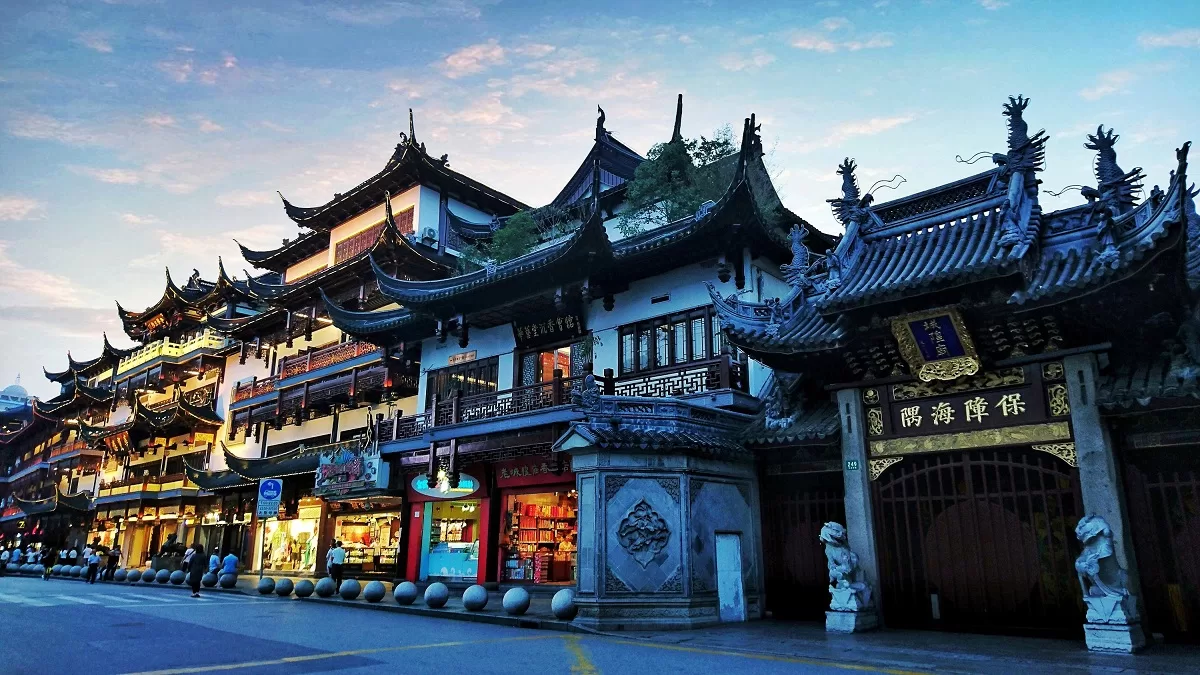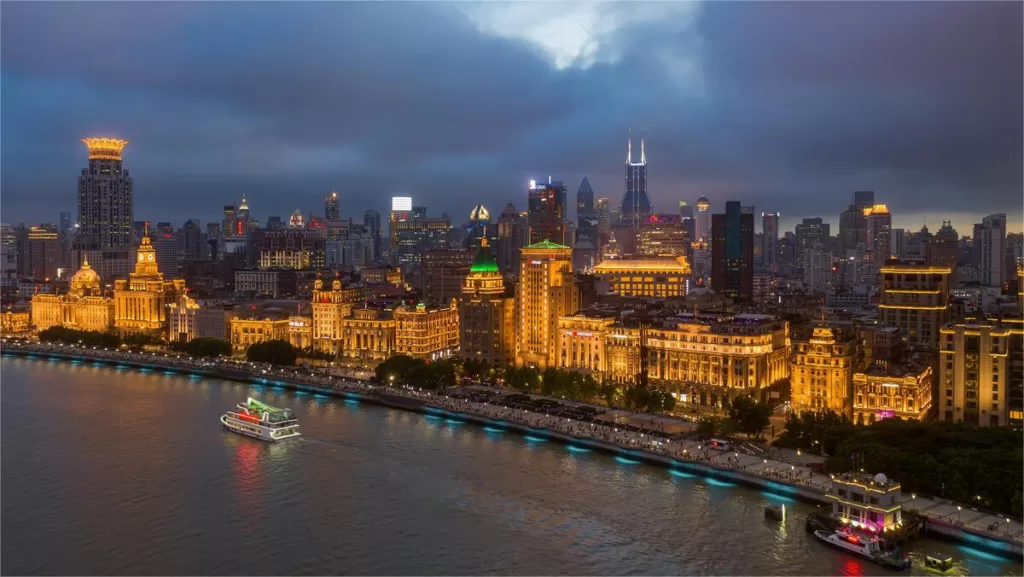The City God Temple (城隍庙), nestled in Shanghai‘s Huangpu District, holds a legendary history dating back over 2,000 years to the Three Kingdoms period. The temple, oriented north to south, spans an area of around 3,000 square meters. Temples dedicated to the city god were established in Shanghai as early as the Tang Dynasty. In 1994, the City God Temple underwent restoration, finally opening its doors to believers on January 31, 1995.
The temple complex encompasses nine main halls, including the Grand Hall, Yuanchen Hall, Parents Hall, Guan Yu Hall, and Wenchang Hall. These structures, built in a typical southern architectural style with red walls and tiled roofs, maintain the grandeur and layout reminiscent of Ming Dynasty architecture. Elaborate eaves, colorful wooden beams, green tiles, and red-painted eaves contribute to its majestic appearance.
The City God Temple area bustles year-round, as it’s not just a religious site but also a renowned commercial hub. Several wholesale shopping centers, comprehensive malls, numerous jewelry stores, and gold shops line the area. Additionally, it hosts a variety of well-established eateries and shops selling an array of Shanghai’s local specialties, making it a haven for both tourists and locals seeking unique cultural experiences and diverse shopping opportunities.
Table of Contents
- Basic Information
- Location and Transportation
- Who is enshrined
- Highlights of Shanghai City God Temple
- Vlog about Shanghai City God Temple
- History of City God Temple
- Useful Tips Summarized from Reviews
- Attractions near the CIty God Temple
- Other Temples in Shanghai
Basic Information
| Estimated Length of Tour | 1 hour |
| Ticket Price | 10 RMB |
| Opening Hours | The temple is open from 8.30 to 16.30. But the commercial areas around it are accessible throughout the day |
| Telephone Number | 0086-021-63284494 |
Location and Transportation
The City God Temple of Shanghai is located in the heart of Shanghai’s Old Town, in the Yu Garden area of Huangpu District. The specific address is No. 249, Fangbang Middle Road, Huangpu District. It is easily accessible by public transportation, with several bus and metro lines stopping nearby.
Bus: Take Tourist line 1 or 3, get off at Chenghuangmiao Yuyuan Stop (City God Temple and Yuyuan Garden), and walk about 100 meters to the northeast to reach the tourist attraction.
Subway: Take subway line 10 or 14, get off at Yuyuan Garden Station, and walk about 500 meters to the southeast to reach the temple.
Who is enshrined
The City God Temple enshrines three main deities, each holding a significant place in Chinese history and mythology.
The first deity enshrined in the temple is Huo Guang (霍光), a prominent figure during the Western Han Dynasty. Huo Guang served as regent for the young emperor and played a crucial role in stabilizing the empire during a period of political turmoil. He is revered as a wise and just ruler who always put the needs of the people first.
The second deity enshrined in the temple is Qin Yubo (秦裕伯), a local hero who lived during the Ming Dynasty. Qin Yubo was famous for his bravery and loyalty, and he was said to have defended Shanghai against pirates and bandits. He is revered as a symbol of courage and resilience, and his memory is cherished by the people of Shanghai.
The third deity enshrined in the temple is Chen Huacheng (陈化成), a general who fought against the British during the First Opium War in the mid-19th century. Chen Huacheng is revered as a martyr for his sacrifice in defending China’s sovereignty, and his memory is an important reminder of the struggles and sacrifices that the Chinese people have made to protect their country.
Highlights of Shanghai City God Temple
Traditional Chinese Architecture

The City God Temple showcases a splendid example of traditional Chinese architecture, with its various halls and structures reflecting centuries of history and cultural significance. The Shanmen, or main gate, was constructed in the 14th year of the Ming Dynasty’s Jiajing era (1535), boasting over 450 years of history. The gate’s stone pillars and wooden beams bear witness to the craftsmanship of the time. Inscribed with golden characters reading “保障海隅” (Ensuring Coastal Security), the inscription was originally composed by Feng Bin, the county magistrate of Shanghai during the Ming Dynasty.
The main hall of the City God Temple features a prominent sign reading “城隍庙” (City God Temple). Inside the hall, a seated statue of General Huo Guang, the god presiding over Jinshan, is enshrined. Flanking him are the civil judge and military judge, while the positions of day and night supervisors are also represented.
The Taishui Hall, also known as the Yuanchen Hall or the Sixty Jiazi Hall, is associated with auspicious moments and signifies favorable times. Dedicated to the god of Taishui, this hall is linked to the annual fortune of individuals.
Cultural Relics

The City God Temple of Shanghai is not only a religious site, but also a cultural relic museum, housing a wide range of cultural relics from different periods of Chinese history. Some of the most notable artifacts include stone inscriptions, ancient bronze statues, and Ming and Qing dynasty porcelain. These artifacts not only showcase the art and craftsmanship of ancient China but also provide insights into the beliefs and customs of people during those times. Visitors can also see traditional Chinese calligraphy, paintings, and other artworks that have been carefully preserved over the years.
Local Food and Souvenir Shops

The area surrounding the City God Temple of Shanghai is a bustling marketplace filled with food and souvenir shops, offering visitors a unique shopping and dining experience. The streets are lined with vendors selling a variety of local delicacies such as steamed buns, dumplings, and rice cakes, as well as snacks like candied fruits and roasted nuts. Visitors can also find many souvenir shops selling traditional Chinese crafts and souvenirs, including paper-cuttings, calligraphy brushes, and silk fans. In addition, there are tea houses, restaurants, and street food stalls offering a wide range of local cuisine.
Lantern Festival

The Lantern Festival is one of the most important festivals celebrated at the City God Temple of Shanghai. It takes place on the 15th day of the first lunar month and marks the end of the Chinese New Year celebrations. The temple is adorned with colorful lanterns, and visitors can participate in various activities, such as writing and hanging lanterns, solving lantern riddles, and watching lion and dragon dance performances. The highlight of the festival is the releasing of lanterns, where visitors write their wishes on lanterns and release them into the night sky.
Vlog about Shanghai City God Temple
History of City God Temple
The Shanghai City God Temple, an iconic site in Shanghai, has a rich history dating back to the Tang Dynasty. The origins of the temple can be traced to the early days of Shanghai’s development when the area was known as Huating County. During the Tang period, Huating County had its own City God Temple located on the west side of the county.
In the Ming Dynasty, during the Yongle period (1403–1424), Zhang Shouyue, then the magistrate of Shanghai, transformed the Jinchang Temple, which was dedicated to the God of Mount Jinchang and the Lord of Mount Bo Lu, into the Shanghai City God Temple. This renovation aimed to honor the City God of Shanghai, Qin Yubo, and marked a significant re-establishment of the temple in its current location.
During the Qing Dynasty, significant developments continued to shape the temple’s structure and significance. In the 49th year of the Kangxi reign (1710), local gentry pooled their resources to construct a garden known as the Eastern Garden (also referred to as the Inner Garden), which was incorporated into the City God Temple complex. This expansion increased the temple grounds to over 12 acres, enhancing its prominence and beauty.
The temple faced significant challenges during periods of conflict. On June 19, 1842, during the First Opium War, British troops occupied the City God Temple for five days, causing extensive damage to the temple. The destruction was severe, leaving the temple in ruins.
In 1853, after the Qing army retook Shanghai, the City God Temple suffered further damage as the city experienced intense battles. By 1860, foreign troops stationed in the city further vandalized the temple, particularly damaging the Yuyuan Garden (a section of the complex).
Restoration efforts began in 1865 under the leadership of Shanghai magistrates Wang Zonglian and Xing Baoshi. They spearheaded fundraising campaigns and repairs that took ten months, restoring the temple to its former grandeur. The improvements included the reconstruction of major structures within the temple grounds.
In 1893, Wang Chengxuan, the Shanghai magistrate at the time, oversaw the fundraising for the construction of new gates, halls, and a drama stage, further enhancing the temple’s infrastructure. By 1894, the temple received the “Bao Li Cang Chi” plaque, acknowledging its significance.
Additional renovations occurred in 1909, when the magistrate Li Chaoqiong led efforts to refurbish the main hall and sleeping quarters. The early 20th century saw further damage and reconstruction. In 1922, a major fire destroyed parts of the temple, leading to a restoration funded by public and government sources. Another fire on July 15, 1924, completely destroyed the main hall, prompting a new rebuilding project that took 20 months, with completion in November 1927.
After the liberation of Shanghai in 1949, the City God Temple’s major hall remained open, but other halls were closed, although the deities were preserved. In 1956, the Shanghai Religious Bureau undertook a major overhaul of the temple, dismantling the board of trustees and reducing temple staff. The Jade Clear Palace and Wenchang Pavilion were closed as part of these reforms.
The Cultural Revolution (1966–1976) had a devastating impact on the City God Temple. Religious activities ceased, and the temple suffered severe destruction, including the complete loss of its statues and relics.
In 1994, efforts began to restore the City God Temple to its former state. By January 31, 1995, the temple officially reopened to the public and devotees, marking the revival of its cultural and religious significance in modern Shanghai. Today, the Shanghai City God Temple stands as a testament to the resilience and enduring heritage of one of the city’s most cherished historical sites.
Useful Tips Summarized from Reviews
Use Public Transportation: Public transportation is the best option for getting to Shanghai City God Temple. Traffic congestion from Henan Middle Road to Nanjing Road can be severe, so it’s advisable to avoid driving. Follow the crowds, and you’ll easily find your way.
Bring Coins for Offerings: Make sure to bring some coins with you, as there are various opportunities for offerings throughout the temple. In the back hall of the temple, there are statues representing the Chinese zodiac signs where visitors can make offerings. Additionally, it’s customary to leave a donation at the main hall and other shrines as a token of respect. If you forget to bring coins, there are self-service coin exchange machines available near the back hall.
Visit in the Afternoon: It’s highly recommended to visit Shanghai City God Temple around 4:00 PM. At this time, it’s not yet dark, allowing you to capture the temple without the lights turned on. The difference between the temple with and without lights is striking, and the nighttime view is equally impressive.
Try Local Delicacies: Don’t miss the opportunity to sample some of the local delicacies while visiting the temple. Highly recommended dishes include xiaolongbao (soup dumplings), shengjianbao (pan-fried buns), traditional Shanghai-style spare ribs with rice cakes, and Qingtuan (glutinous rice balls). These foods offer a taste of authentic Shanghai cuisine.
Convenient Access to Yuyuan Garden: After exploring Shanghai City God Temple, you can exit through the back door to reach Yuyuan Garden directly without having to take a detour.











The night view of Chenghuang Temple pedestrian street is really beautiful, with the lights making it feel different. Of course, there are also a lot of people. The whole street is in Chinese style, and I really like our excellent traditional Chinese culture. There are also many foreign tourists here taking photos and eating. Recommended snacks: Song He Lou (a Suzhou-style noodle restaurant, really delicious, they also have soup dumplings, which are also very good); Nanxiang Mantou (a soup dumpling… Read more »